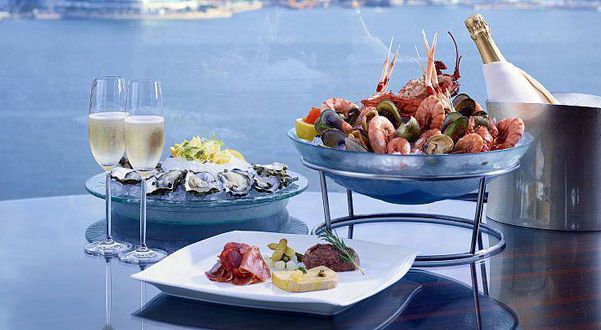France, Spain, Italy, Great Britain; every country has its unique traditions and specialties with respect to chocolate. From rich hot cocoa, to hand-made confections, drop dead dense cakes, creamy ice creams, airy mousses and souffles; intense sauces and an endless variety of bars, there is a chocolate that appeals to every palate. French chocolate is recognized for the fineness of its Ganache (a filling made of chocolate, butter and cream), praline chocolates and other fine chocolates with fruity, tangy and floral flavors which come together in time-honored recipes.
How to recognize great chocolate?
Chocolate, Good Chocolate or Grand Chocolate... It is not always easy to distinguish great chocolate from the ordinary. To do so requires keen use of all your senses – but richly rewarding from start to finish. To the eye, the deep mahogany tones of its outer covering should seem to shine with perfect uniformity. Milk chocolate should be auburn brown, appear to glow from within, the degree of darkness varying according cocoa content. To the touch, fine chocolate is firm, yet will not crumble. When placed in proximity of your nose, subtle aromas both reveal and contribute to its taste while stimulating your anticipation. The expert hand circumspectly breaks it, releasing a wave of robust aromas and delicate flavors. Finally, in the mouth, an unmistakable sound reverberates as your teeth release its full flavor in minute, dissolving morsels. Its texture reveals itself to your palate; radiant and striking, yet not overwhelming, a harmonious, distinctive bouquet like a great wine.
Chocolate, Good Chocolate or Grand Chocolate... It is not always easy to distinguish great chocolate from the ordinary. To do so requires keen use of all your senses – but richly rewarding from start to finish. To the eye, the deep mahogany tones of its outer covering should seem to shine with perfect uniformity. Milk chocolate should be auburn brown, appear to glow from within, the degree of darkness varying according cocoa content. To the touch, fine chocolate is firm, yet will not crumble. When placed in proximity of your nose, subtle aromas both reveal and contribute to its taste while stimulating your anticipation. The expert hand circumspectly breaks it, releasing a wave of robust aromas and delicate flavors. Finally, in the mouth, an unmistakable sound reverberates as your teeth release its full flavor in minute, dissolving morsels. Its texture reveals itself to your palate; radiant and striking, yet not overwhelming, a harmonious, distinctive bouquet like a great wine.
Where should you taste it?
Modernization of production techniques have wrought enormous improvements in the refining and conserving of cocoa. Chocolate makers seeking to fulfill an unceasing demand for more product have gravitated inexorably toward standardization and homogeny of taste. Consequently, one of the most precious attributes of traditional chocolate confections, the distinctly individual flavor varying from batch to batch has been lost. Chocolate's individuality of flavor can be traced to the origin and type of cocoa beans. Mass produced chocolate, not unlike blended scotch whiskey, blends many beans from many areas, sacrificing uniqueness for uniformity.
Modernization of production techniques have wrought enormous improvements in the refining and conserving of cocoa. Chocolate makers seeking to fulfill an unceasing demand for more product have gravitated inexorably toward standardization and homogeny of taste. Consequently, one of the most precious attributes of traditional chocolate confections, the distinctly individual flavor varying from batch to batch has been lost. Chocolate's individuality of flavor can be traced to the origin and type of cocoa beans. Mass produced chocolate, not unlike blended scotch whiskey, blends many beans from many areas, sacrificing uniqueness for uniformity.
Fortunately, there are still a small number of chocolate makers dedicated to quality instead of quantity. There are also an increasing number of people who appreciate more natural, time-honored chocolate. Demand for quality chocolates by enthusiasts who embrace its full-bodied aromas and unapologetic flavors has contributed to the preservation and even improvement of traditional recipes, methods and ingredients. Until recently, to experience truly exceptional chocolate, one had to visit the intimate confines of an artisan's shop. Now it is also possible to obtain these rare delicacies via the Internet. Gourmet chocolate appears to be emulating the increasing availability of fine wine. As demand grows, the number of smaller, lesser known makers expands. Also like wine, great chocolate usually comes at a higher price! The old adage, you get what you pay for is almost always true when it comes to great chocolate. When seeking it out, carefully read the ingredients and the description of the production technique employed. This will at least provide you an indication of the quality of the finished product.
Where can you learn to taste it?
Not sure that your palate can recognize all these differences? Nothing could be more enjoyable than learning how and it is easier today than ever before! More and more master chocolate makers are offering the opportunity to participate in chocolate tasting classes to discover real chocolate.
L'Institut d'Etudes Supérieures des Arts (IESA, The Higher Art Institute) has created the first University of Chocolate. A course for beginners and enthusiasts who want to develop their knowledge of this food with a thousand sublime flavors. Outstanding seminar speakers offer new concepts that are certain to seduce and delight.
Not sure that your palate can recognize all these differences? Nothing could be more enjoyable than learning how and it is easier today than ever before! More and more master chocolate makers are offering the opportunity to participate in chocolate tasting classes to discover real chocolate.
L'Institut d'Etudes Supérieures des Arts (IESA, The Higher Art Institute) has created the first University of Chocolate. A course for beginners and enthusiasts who want to develop their knowledge of this food with a thousand sublime flavors. Outstanding seminar speakers offer new concepts that are certain to seduce and delight.
For tasting the best France chocolate visit:
PR & Special
Events Manager
adria@zchocolat.com
+33 (0)4.42.91.43.67
office line
+33 (0)6.29.78.12.76 Mobile
+33 (0)6.29.78.12.76 Mobile
5, rue Fabrot - 13100
Aix-en-provence - FRANCE
Website
Press review
Product Catalogue
http://www.zchocolat.com/download/catalogue_en.pdf 














No comments:
Post a Comment